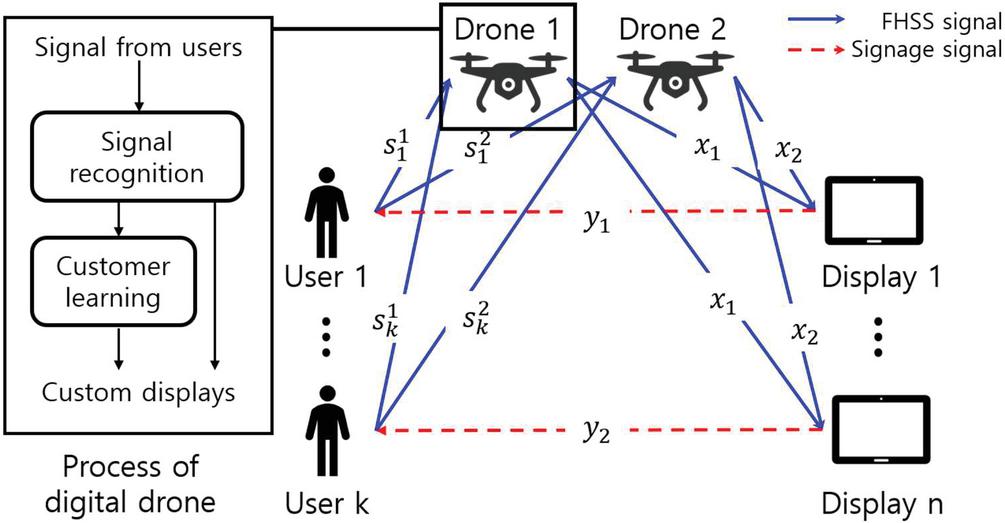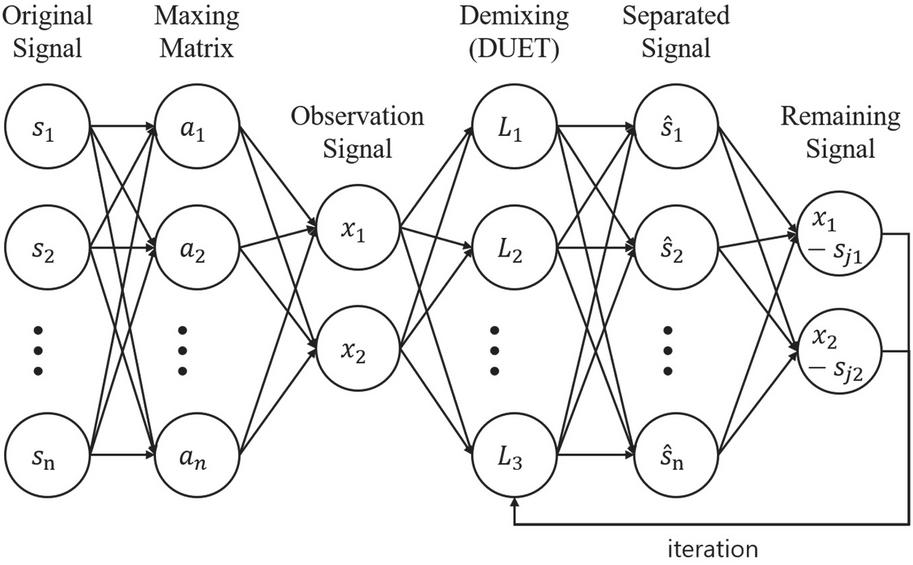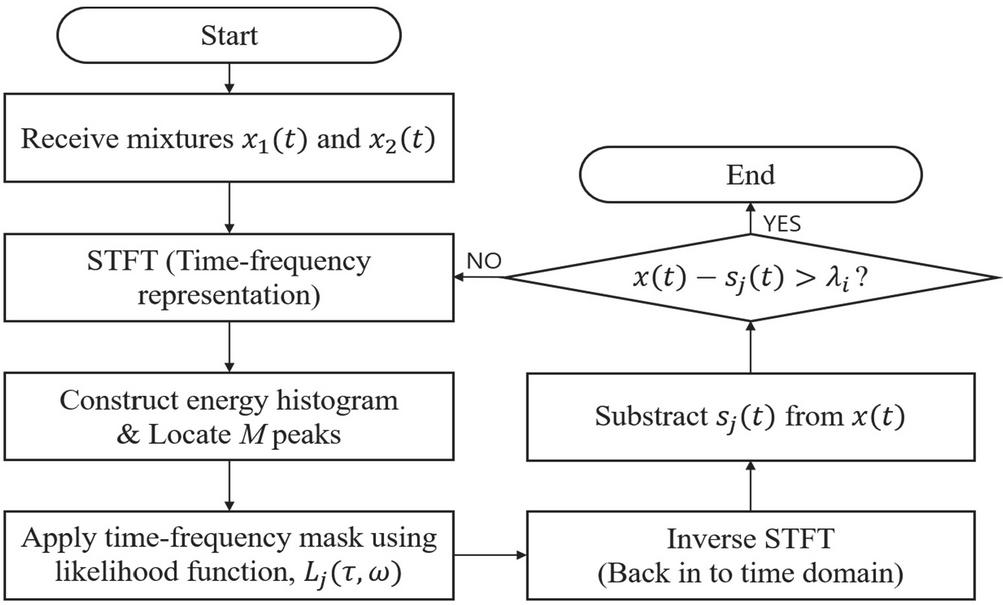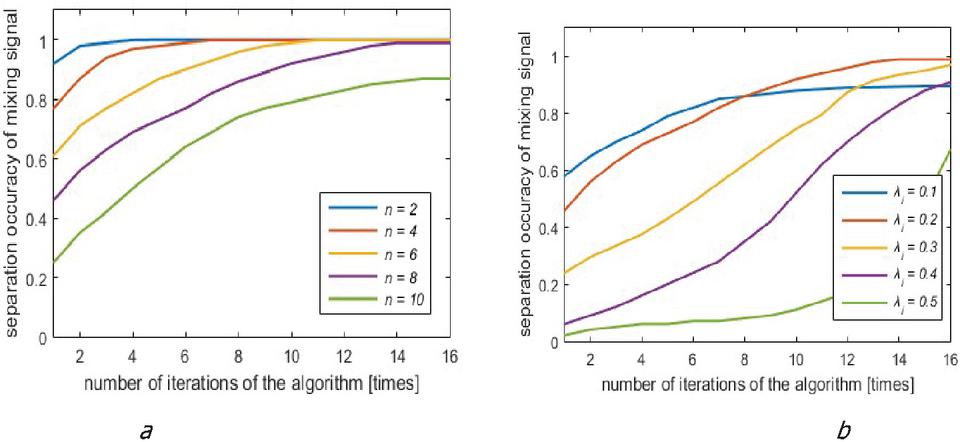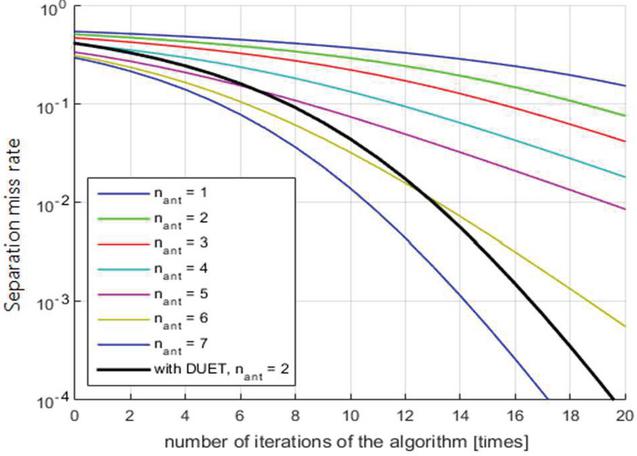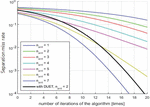Performance of Digital Drone Signage System Based on DUET
Isaac Sim1,*, Young Ghyu Sun1, Soo Hyun Kim1, SangWoon Lee2, Cheong Ghil Kim3 and Jin Young Kim1
1Department of Electronic Convergence Engineering, Kwangwoon University, Seoul, Korea
2Department of Multimedia, Namseoul University, Cheonan 31020, Seoul,
Korea
3Department of Computer Science, Namseoul University, Cheonan 31020, Seoul, Korea
E-mail: dltkr34@naver.com; yakrkr@kw.ac.kr; jinyoung@kw.ac.kr; quattro@nsu.ac.kr;chkim@nsu.ac.kr
Corresponding Author
Received 28 April 2021; Accepted 14 October 2021; Publication 03 January 2022
Abstract
In this letter, we study a scenario based on degenerate unmixing estimation technique (DUET) that separates original signals from mixture of FHSS signals with two antennas. We have shown that the assumptions for separating mixed signals in DUET can be applied to drone based digital signage recognition signals and proposed the DUET-based separation scheme (DBSS) to classify the mixed recognition drone signals by extracting the delay and attenuation components of the mixture signal through the likelihood function and the short-term Fourier transform (STFT). In addition, we propose an iterative algorithm for signal separation with the conventional DUET scheme. Numerical results showed that the proposed algorithm is more separation-efficient compared to baseline schemes. DBSS can separate all signals within about 0.56 seconds when there are fewer than nine signage signals.
Keywords: Degenerate unmixing estimation technique (DUET), digital signage, DUET-based separation scheme (DBSS), drones.
1 Introduction
As the market for commercial drones grows, unauthorized drones in certain areas can cause security problems. Techniques for isolating RF signals for detecting unlicensed drones are becoming increasingly important. The blind signal separation (BSS) technique is used to distinguish a signal source when an unknown signal is received. To distinguish signals, antennas are needed as many as the number of signal sources, which has many disadvantages in terms of complexity [1–5]. At the same time, due to spread of commercial drone using frequency hopping spread spectrum (FHSS) on industrial scientific medical (ISM) band, related BSS methods have been variously studied [6–9]. The degenerate unmixing estimation technique (DUET), as one of the BSS methods, was proposed to distinguish voice signals with only two microphones regardless of the number of signal sources [10–13]. In these previous studies, even though the DUET is studied in a RF-domain with MIMO systems, these studies require equal number of signal sources and antennas, which is not appropriate in environments with multiple drones using FHSS signals. In recent, a digital signage system has been proposed to provide customized information for drones [14–17].
In this paper, we demonstrate that the DUET method, which is previously used only for voice signals, can be used for FHSS as well, using the assumptions used in DUET. It also provides a way to effectively classify the FHSS signals transmitted and received through the ISM band in multiple drone’s environment. The proposed algorithm, DUET-based separation scheme (DBSS), adds an iteration process to the DUET so that it can be demodulated even in environments with many sources. In addition, only two receive antennas are used regardless of the number of signage signal sources, preventing performance degradation caused by the complexity of receivers. We also simulated how the performance changes depending on the parameters that determine the iteration and the number of signal sources.
The remainder of this letter is as follows. In Section 2, we formulate whether the DUET method can be applied to digital signage signal. In Section 3, we give a solution for the problem. The simulation results and conclusions are presented in Sections 4 and 5, respectively.
2 Applicability of DUET to Digital Signage Drone Signals
Figure 1 illustrates the proposed digital signage system based on digital drones. The two digital drones use the DUET algorithm to identify the user’s signals and pass them on to the display. Digital drones can perform physical relays and signal recognition processes of RF signals. Digital drone is used in next-generation signage system because it can control wireless signals flexibly regardless of physical constraints. Through this, the display can transmit suitable signage for each user. In order to distinguish current FHSS signals, the same number of antennas should be used. This is not appropriate in environments where multiple drones are operated.
Figure 1 A system model of digital signage display based on two digital drones.
DUET scheme is a system model used to separate the mixed audio signals by frequency, but it can also be applied in a mixed environment of FHSS signals. In DUET, the following four assumptions should be applied [10]. The DUET method is implemented under four assumptions: Anechoic Mixing, W-Dispoint Orthogonality, Local Stationary, and Microphone Closed Together [18 , 19].
Anechoic Mixing assumes that the environment where the signal source exists is Line of Sight. The condition is satiated with the drone operated only in the outer field. W-Dispoint Orthogonality is an assumption that the source of the signal is independent. This acceptance is accepted for the drones because the FHSS signal generated by the drones has different factors. Local Stationary is the assumption that the signal source does not affect other signal information All the drones performance with their communication with their response transmits, then FHSS signal from the drones satisfying the charges. Microphone Closed Together assumed that the distance between the antennas should be less than a certain level. In this paper, the DUET simulation limits the distance between the antennas to less than 5 cm.
We agreed that the four options in the DUET can be applied to the FHSS signal used by the Drone.
Figure 2 System model of proposed DBSS algorithm.
3 Feasibility of DUET to FHSS Signals
Figure 2 illustrates the identification of FHSS signals in the DUET scheme. The original signal s is represented by the mixture signal a caused by multipath channel. DUET method uses two antennas that demodulated the mixture signal a estimate the number of digital signage signals. Figure 3 illustrates the proposed algorithm for separate FHSS signals on field. First, it receives the mixer signals x_1 (t) and x_2 (t) for two antennas as shown in Equation (1). A short-term Fourier transform of the time-domain signals of Equation (1) yields a signal expressed as a time-frequency value . Also, by applying the W-Disjoint Orthogonal (W-DO) assumption of the Fourier transform pair and the signal of drones, the following equation can be obtained:
| (1) |
Then, solving the above simultaneous equations, we can estimate the parameters representing the relative attenuation between channels and the delay as follows:
| (2) |
We can estimate the energy histogram for all and and find the position of the peak component in the obtained histogram. Given a using the following equation:
| (3) |
(3) is the separated signal from STFT form of the received signal . Through this subtraction, the sum of the non-separated signals can be obtained. In this algorithm, this process is repeated until the average power of the unseparated signal is less than iteration threshold . The lambda is set to the ratio of received power of the mixture signal .
The algorithm pseudocode for DBSS is described as follows.
Algorithm 1 The proposed algorithm of iteration DUET
1: Input: mixture signal , threshold
2: Construct STFT for input
3: While
4: Initialize simultaneous Equation (7),
5: Update
6: Construct Inverse-STFT of separated signal
7: Output: separated signal , separation accuracy
Figure 3 The proposed algorithm of iteration DUET for digital signage signals.
4 Simulation Results
In this section, we provide simulation results to show the effectiveness of DBSS. The system is set up as follows:
Table 1 Simulation parameters
| Parameter | Value |
| Center frequency | 2.45 GHz |
| Distance between drones | 5 meters |
| Distance between drone and receiver | 120 meters |
| Hopping channel | 24 channels |
| Frame rate (iteration time) | 22ms |
| Receiver | NI USRP-2920 |
| Modulation | BPSK |
| Sampling times |
Figure 4 Signal separation accuracy versus iteration of proposed algorithm (a) when and (b) when .
Figure 5 Signal separation accurate curve with and without DBSS method.
Figure 4 shows a simulation of full separation probability according to the number of signal sources. In Figure 4(a), when the number of signal sources is 8 or less, the DBSS can separate the received FHSS signal within 0.56 seconds (STFT calculation and 12 iteration). Commercial drones are usually operated at 250 meters and at a flight speed of 40 km/h, so the FHSS operation speed is enough to control the unlicensed drones. Figure 4(b) shows a performance simulation based on the value of the iteration threshold for the same number of signal sources (n 8). If the lambda is too high ( in Figure 4), it will not be able to isolate the signal and will only iterate the algorithm with the same input. Therefore, we need to set proper depending on the number of sources.
Figure 5 shows the accuracy of separation of FHSS signals with and without the DBSS method. The number of signal sources is seven, and is the number of antennas. When DBSS is not used, the performance difference clearly varies according to the number of antennas. Using the DBSS method, you can achieve performance like using 6 antennas while using only 2 antennas.
5 Conclusion
In this letter, we have proposed an iterative DBSS algorithm based on DUET system to separate the digital signage signals from drones. Using the proposed algorithm, we can optimally separate multiple FHSS signals using only two antennas. Simulation results demonstrated the signal can be separated effectively through proper adjustment of the parameters.
Acknowledgment
This research was supported by the MSIT (Ministry of Science and ICT), Korea, under the ITRC (Information Technology Research Center) support program (IITP-2021-2018-0-01424 and IITP-2021-0-01846) supervised by the IITP (Institute for Information & communications Technology Promotion).
References
[1] S. A. W. Shah, K. Abed-Meraim and T. Y. Al-Naffouri, “Blind source separation algorithms using hyperbolic and givens rotations for high-order QAM constellations,” IEEE Trans. Signal Process., vol. 66, no. 7, pp. 1802–1816, Apr. 2018.
[2] A. Ferreol, P. Chevalier, L. Albera, “Second-order blind separation of first- and second-order cyclostationary sources–Application to AM, FSK, CPFSK, and deterministic sources”, IEEE Trans. Signal Process., vol. 52, no. 4, pp. 845–861, Apr. 2004.
[3] J. L. Loof and T. G. Pratt, “Blind Separation of Frequency-Hopped Signals Using a Space-Polarization Receiver,” in IEEE Signal Processing Letters, vol. 26, no. 7, pp. 1061–1064, July 2019.
[4] W. Wang, R. Wu and J. Liang, “ADS-B Signal Separation Based On Blind Adaptive Beamforming,” in IEEE Transactions on Vehicular Technology, vol. 68, no. 7, pp. 6547–6556, July 2019.
[5] J. Treichler and B. Agee, “A new approach to multipath correction of constant modulus signals,” IEEE Trans. Acoust., Speech, Signal Process., vol. 31, no. 2, pp. 459–472, Apr. 1983.
[6] O. Yilmaz and S. Rickard, “Blind separation of speech mixtures via time-frequency masking”, IEEE Trans. Signal Processing, vol. 52, no. 7, pp. 1830–1847, July 2004.
[7] P. Comon and C. Jutten, Handbook of Blind Source Separation: Independent Component Analysis and Applications. Amsterdam, The Netherlands: Elsevier, 2010.
[8] K. Abed-Meraim, Y. Xiang, J. H. Manton, and Y. Hua, “Blind source separation using second-order cyclostationary statistics,” IEEE Trans. Signal Processing, vol. 49, pp. 694–701, Apr. 2001.
[9] Zhe Wang, Luyun Wang, Xiumei Li, Lifan Zhao, Guoan Bi, “Underdetermined Separation of Speech Mixture Based on Sparse Bayesian Learning”, Mathematical Problems in Engineering, vol. 2016, pp. 1, 2016.
[10] H. Cramér, Random Variables and Probability Distributions, vol. 36. Cambridge, U.K.: Cambridge Univ. Press, 2004.
[11] J. V. Stone, “Independent Component Analysis: A Tutorial Introduction,” Massachusetts Institute of Technology, 2004.
[12] C. Simon, P. Loubaton, and C. Jutten, “Separation of a class of convolutive mixtures: A contrast function approach,” 1999 IEEE International Conf. Acoustics, Speech, and Signal Processing (ICASSP99), vol. 81, no. 4, pp. 883–887, Apr. 2001.
[13] Navya Amin, Thomas Gross, Marvin Offiah, Susanne Rosenthal, Markus Borschbach, “Comparative study on convolutive BSS algorithms for an app-based assistance system scenario”, Smart Sensors and Systems (IC-SSS) International Conference on, pp. 1–6, 2015.
[14] S. NT, P. N. Koundinya and P. Rajalakshmi, “Novel technique for Multi Sensor Calibration of a UAV,” 2020 IEEE International Conference on Computing, Power and Communication Technologies (GUCON), Greater Noida, India, 2020, pp. 778–782.
[15] H. Unno and K. Uehira, “Invisibility and Readability of Temporally and Spatially Intensity-Modulated Metaimage for Information Hiding on Digital Signage Display System,” in IEEE Transactions on Industry Applications, vol. 55, no. 6, pp. 6559–6566, Nov.–Dec. 2019.
[16] H. Okada, S. Sato, T. Wada, K. Kobayashi and M. Katayama, “Preventing Degradation of the Quality of Visual Information in Digital Signage and Image-Sensor-Based Visible Light Communication Systems,” in IEEE Photonics Journal, vol. 10, no. 3, pp. 1–9, June 2018.
[17] X. Zhang et al., “A Digital Signage Audience Classification Model Based on the Huff Model and Backpropagation Neural Network,” in IEEE Access, vol. 8, pp. 71708–71720, 2020.
[18] Makino, T. W. Lee, and H. Sawada., Blind speech separation, Springer, 217–241. 2007.
[19] A. Singh and R. S. Anand, “Overview of the performance of fast ICA and DUET for blind source separation of multiple speakers,” 2015 National Conference on Recent Advances in Electronics & Computer Engineering (RAECE), Roorkee, 2015, pp. 296–300.
Biographies
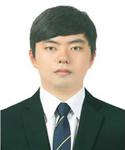
Isaac Sim received the B.Sc. and M.Sc. degrees (magna cum laude) from the Department of Electronic Convergence Engineering, Kwangwoon University, Seoul, South Korea, in 2016 and 2018, respectively, where he is currently pursuing the Ph.D. degree. His research interests include wireless energy harvesting, the internet of energy, wireless sensor networks, artificial intelligence, etc.

Young Ghyu Sun received the B.Sc. (summa cum laude) and M.Sc. degree from the Department of Electronic Convergence Engineering, Kwangwoon University, Seoul, Korea, in 2018 and 2020, respectively, where he is currently pursuing the Ph.D. degree. He was a recipient of the IEEE Student Paper Gold Award in 2020. His research interests include wireless communications, wireless energy harvesting, deep learning, Internet of energy, etc.
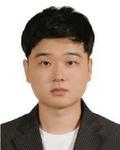
Soo Hyun Kim received the B.Sc. and M.Sc. degree from the Department of Electronic Convergence Engineering, Kwangwoon University, Seoul, Korea, in 2019 and 2021, respectively, where he is currently pursuing the Ph.D. degree. His research interests include wireless communication systems, and machine learning applications for internet of energy etc.
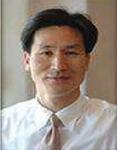
SangWoon Lee received the B.S., M.S. in electrical engineering and Ph.D degrees in electrical and electronics engineering from Yonsei University, Seoul, Korea, in 1987, 1989 and 2005, respectively. From 1991 to 2005, he worked as a research engineer and project manager of R&D Center of MBC (MunHwa Broadcasting Corp.), Seoul Korea. In 2005, he joined Yonsei University, Seoul, Korea, as a Research Professor in the Dept. of Electrical and Electronics and a research fellow for the CABT (Center for Advanced Broadcast Technology). Currently, he is working as a professor in the Department of Multimedia at Namseoul University, Cheon-An City Korea. His main research areas are mobile multimedia broadcasting and intelligent transportation systems. He is active as a Korean Deligate for ITU-R SG6, SG1, and ISO TC204 and President of Korea ITS Society.

Cheong Ghil Kim received the B.S. degree in computer science from the University of Redlands, CA, USA, in 1987, and the M.S. and Ph.D. degrees in computer science from Yonsei University, South Korea, in 2003 and 2006, respectively. He is currently a Professor with the Department of Computer Science, Namseoul University, South Korea. His research areas include multimedia embedded systems, mobile AR, and 3-D contents.
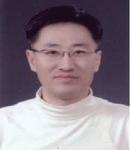
Jin Young Kim received the B.S., M.S., and Ph.D. degrees from the School of Electrical Engineering, Seoul National University (SNU), Seoul, Korea, in 1991, 1993, and 1998, respectively. He was Member of Research Staff at the Institute of New Media and Communications (INMC) and at the Inter-university Semiconductor Research Center (ISRC) of the SNU from 1994 to 1998. He was Postdoctoral Research Fellow at the Department of Electrical Engineering, Princeton University, NJ, U.S.A, from 1998 to 2000. He was Principal Member of Technical Staff at the Central Research and Development Center, SK Telecom, Korea, from 2000 to 2001. He is currently Full Professor at the School of Electronics Engineering, Kwangwoon University, Seoul, Korea. He had his sabbatical leave as Visiting Scientist at the LIDS (Laboratory of Information and Decision Systems), Massachusetts Institute of Technology (M.I.T), MA, U.S.A from 2009 to 2010. His research interests include design and implementation of wireline/wireless multimedia communication systems for applications to spread-spectrum, cognitive radio, ultrawideband (UWB), powerline communication with basis on modulation/demodulation, synchronization, and detection and estimation theory. He received the Best Paper Awards from several academic conferences and societies including Jack Neubauer Best Systems Paper Award from IEEE VT Society (2001), the Award of Prime Minister of Korea Government (2011), He is now Senior Member of IEEE, Regular Member of IET and IEICE.
Journal of Web Engineering, Vol. 21_2, 391–404.
doi: 10.13052/jwe1540-9589.21211
© 2022 River Publishers
